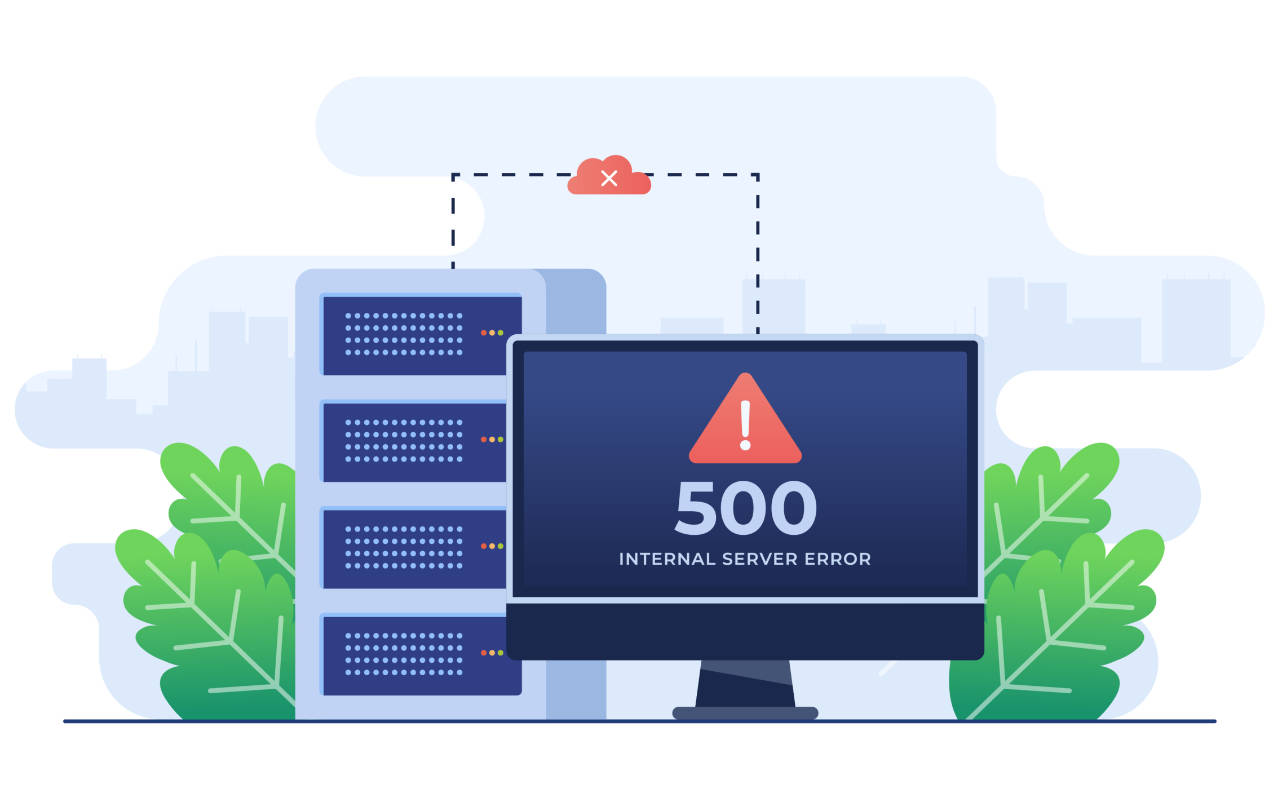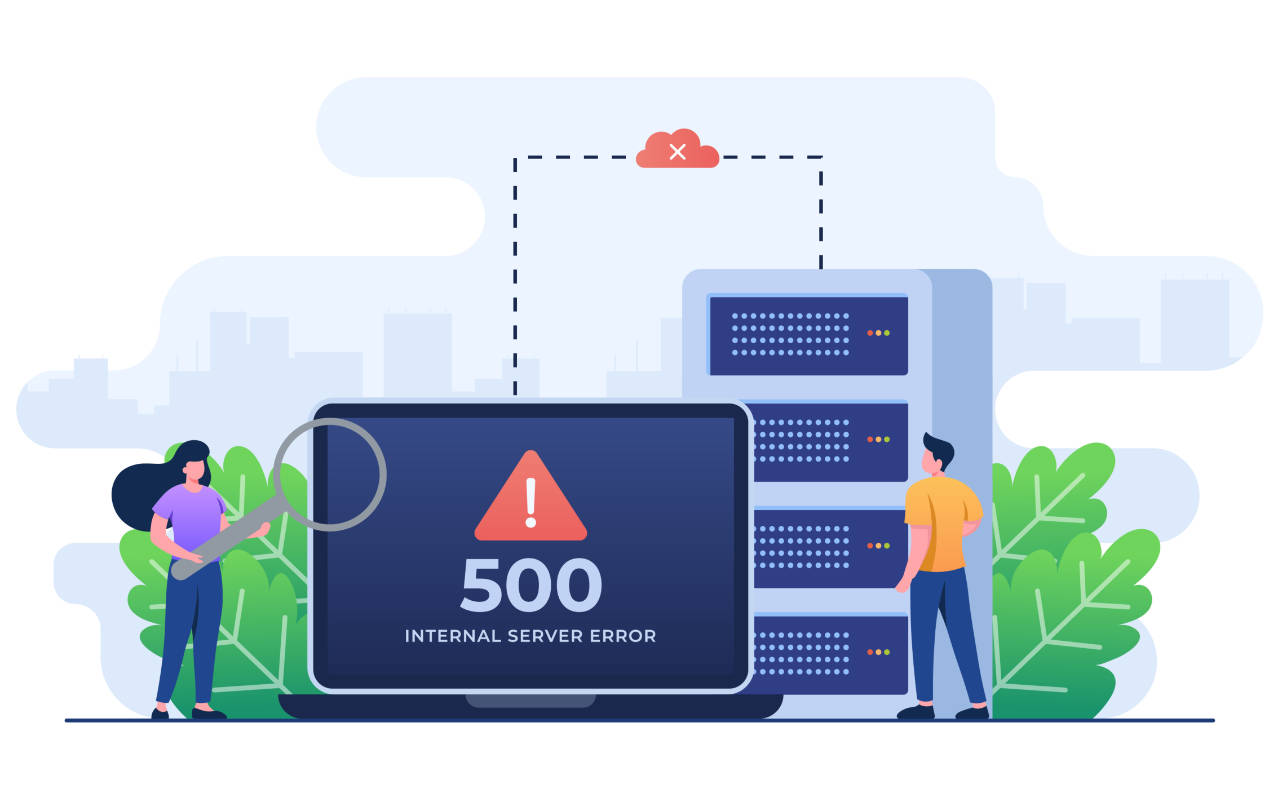Understanding 500 server error codes
Server errors can be a real headache, especially for SMEs trying to keep a seamless online presence.
Among these, the 500 server error code stands out as a common and often confusing issue. But not all 500 server error codes are the same, with some caused by the tiniest mistake in a website’s code or network lag.
We’ll explain everything you need to know about 500 server errors – how they happen, the consequences if you don’t stay on top of them and the practical solutions that can get your business back online and thriving.
What is a 500 server error?
A 500 server error, also known as an Internal Server Error, means there’s a problem with the server hosting your website.
Unlike client-side errors (those in the 400 range), which are usually caused by issues on the visitor’s end, a 500 error suggests something has gone wrong with the server itself. When this error happens, it means the server has hit an unexpected condition that stopped it from fulfilling the request.
 The most common types of 500 server error codes
The most common types of 500 server error codes
While the generic 500 error is the most well-known, there are several specific codes within the 500 range that can offer more insight into the problem, such as if it’s a temporary or permanent issue. Here’s a list of codes you should know:
1. 500 internal server error
This is the catch-all error message for server issues that don’t fit into a more specific category. It indicates a general problem on the server, often due to script errors or misconfigurations.
2. 501 not implemented
This error happens when the server doesn’t support the functionality needed to fulfil the request. It often comes from unimplemented server features or unsupported methods.
3. 502 bad gateway
A 502 error means one server got an invalid response from another server it was accessing to fulfil the request. This can be due to network errors, server overload, or misconfigured proxy settings.
4. 503 service unavailable
This error means the server is temporarily unable to handle the request, usually due to maintenance or overload. It’s often accompanied by a Retry-After header, showing when the service will be available again.
5. 504 gateway timeout
A 504 error happens when one server doesn’t get a timely response from another server it was trying to access. This is often due to network connectivity issues or slow server processing times.
Find out more about website terminology – learn 64 must-know web terms before starting a web project
What are the most common causes of 500 server errors?
There are lots of of reasons why a 500 server error can happen – and you can’t fix one without knowing what it is. Some of the typical culprits include:
Script errors
Many websites rely on scripts to perform various functions. If a script is badly written or has a bug in the code, it can trigger a 500 error. This is especially common with PHP scripts, which are widely used in web development.
Permissions issues
File permissions on your server dictate who can read, write, or execute a file. Incorrect permissions can lead to a 500 error, as the server might be unable to access the necessary files to process a request.
.htaccess errors
The .htaccess file is a configuration file used by Apache servers to manage server behaviour. Errors in this file, such as incorrect directives or syntax errors, can cause a 500 error.
Exhausted PHP memory limit
Web applications sometimes need more memory than the allocated PHP limit. When the memory limit is reached, it can lead to a 500 error, as the server can’t process the resource-intensive request.
Server overload
If your server is handling too many requests at once or running resource-intensive processes, it can become overloaded, resulting in a 500 error. This is often a temporary issue, but it can indicate the need for server optimisation or scaling.
Read about what an SEO agency does and why you need one.
 What’s the impact of 500 errors on my business?
What’s the impact of 500 errors on my business?
For businesses, especially those that rely on their digital presence, a 500 error can have many negative impacts:
- Loss of revenue – If your website is down, potential customers can’t make purchases or enquiries, leading to lost sales opportunities.
- Damage to brand reputation – Frequent downtime can frustrate users and damage your brand’s credibility, making them less likely to return.
- SEO implications – Search engines may penalise your site for repeated errors, impacting your search rankings and visibility.
- Loss of customer trust – Regular website issues can lead customers to question the reliability of your services, driving them to competitors.
- Increased customer support load – Downtime often results in more customer queries, putting pressure on your support team.
- Disrupted user experience – Errors interrupt the seamless experience your users expect, leading to frustration and increased bounce rate.
- Impact on marketing campaigns – Website downtime can undermine the effectiveness of time-sensitive marketing, wasting valuable resources.
Understanding these shows the importance of quickly addressing 500 errors for a positive business image and to keep things running smoothly.
Discover Submerge’s full suite of technical SEO agency services.
 How to diagnose and fix 500 errors
How to diagnose and fix 500 errors
Now that we’ve identified the common causes, find out how to diagnose and fix 500 errors effectively.
Check logs for error messages
Server logs are a great resource when diagnosing issues. Check your server’s error logs for specific error messages or time stamps that can help pinpoint the problem. This is often the first step in identifying whether the error is due to scripts, permissions, or server overload.
Review .htaccess file
Since .htaccess errors can easily trigger a 500 error, review this file for any incorrect directives or syntax errors. If you’ve recently made changes to it, consider going back to a previous version to see if that fixes the issue.
Increase PHP memory limit
If a script is using more memory than allocated, you might need to increase the PHP memory limit. This can usually be done by editing the php.ini file or adding a line to the .htaccess file. But be careful – increasing memory limits can sometimes hide inefficiencies in your code.
Verify file permissions
Make sure that file permissions are set correctly. Directories should typically have permissions set to 755 and files to 644. Incorrect permissions can stop the server from accessing necessary resources, leading to a 500 error.
Contact your hosting provider
If you’re unable to diagnose the issue on your own, reach out to your hosting provider. Their support team can offer insights into server-specific issues and may be able to resolve problems on their end.
How to prevent future 500 errors
While it’s impossible to eliminate all server errors, there are things you can do to minimise the chances of them happening:
1. Regularly update software
Keep your server software, CMS, plugins, and scripts updated. Updates often include bug fixes and security patches that can prevent errors. An outdated system is more susceptible to errors and security vulnerabilities, which can lead to unexpected downtime.
2. Optimise your code
Efficient, well-written code is less likely to cause server errors. Regularly review and optimise your scripts to make sure they run smoothly. Think about doing code audits to spot potential issues before they become problems.
3. Monitor server performance
Use monitoring tools to watch your server’s performance. These tools can alert you to potential issues before they lead to errors. Set up alerts for unusual spikes in server load or traffic so you can respond quickly.
4. Implement a robust backup plan
Regular backups mean you can quickly restore your website to a previous state in case of errors, minimising downtime and data loss. Automate your backup process to make sure it’s consistent and reliable, giving you peace of mind.
5. Consider server scaling
If your business is growing, your server needs may change. Think about upgrading your hosting plan or using a content delivery network (CDN) to handle increased traffic and reduce server strain, since scalability can keep your website strong, even during traffic surges.
If you want to keep a consistent online presence, understanding and managing 500 server errors is essential.
We can help! Submerge’s technical SEO audit services can help find any potential server errors that could be hindering your online performance.
Contact us for a chat about your needs.
Nicole Percival
Nicole has been in the marketing and PR industries since she graduated university in 2019, but has been at Submerge since 2021. A keen reader and horror fanatic, Nicole has enjoyed writing since she was a small child, and has covered industries including consumer tech, food and beverages, business compliance, education, film and entertainment, and wellbeing.
Related Digital Marketing Resources
19/03/2025
10 best Domain Authority checkers
Understand your website's standing with a domain authority checker and take…
15/03/2025
Domain Authority – what is it and how do I boost it?
Find out what is domain authority and how it impacts your website's performance…
22/01/2025
URL parameters and how they affect SEO
Learn the importance of URL parameters in SEO. Find out how they can impact…


